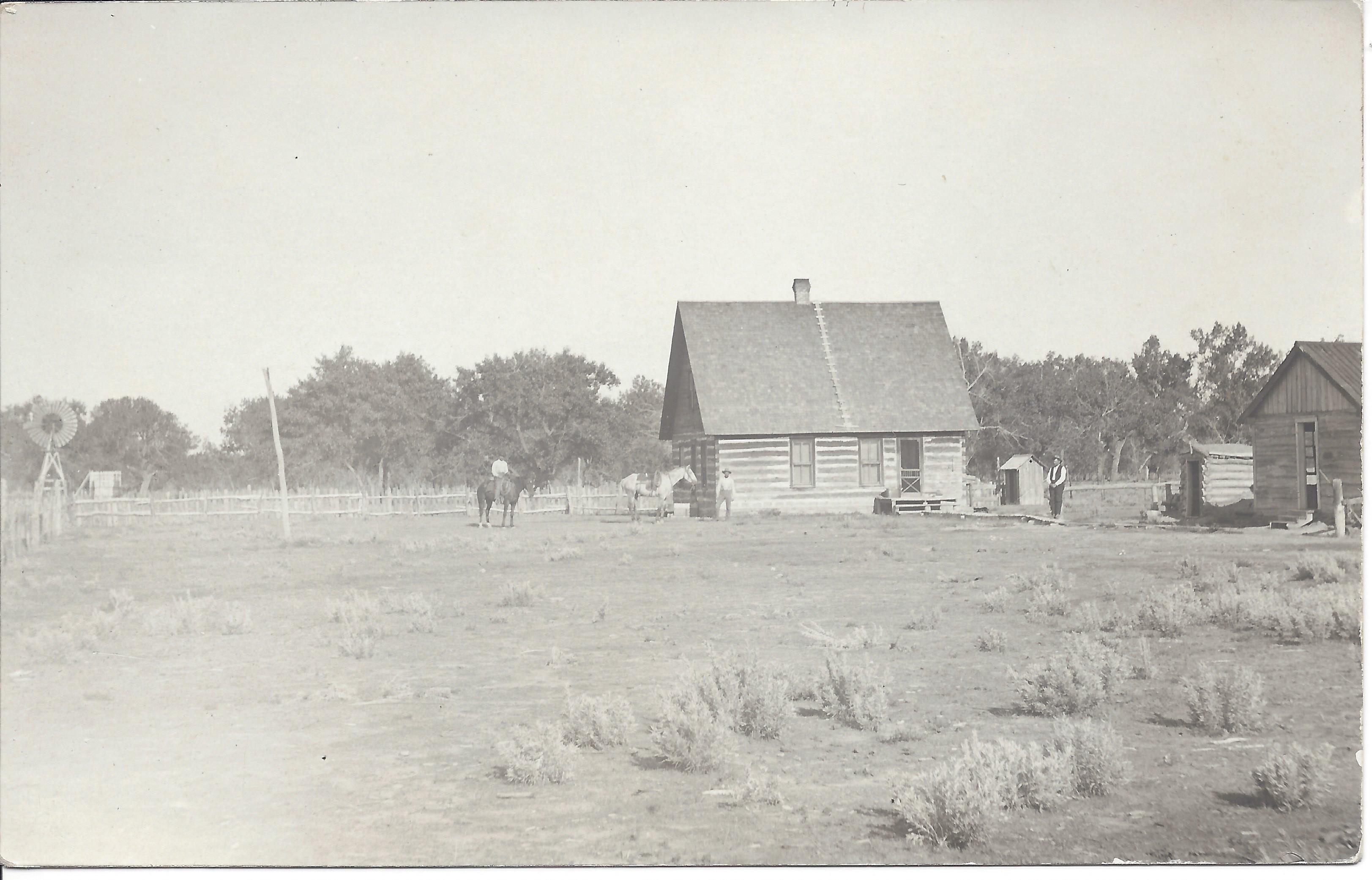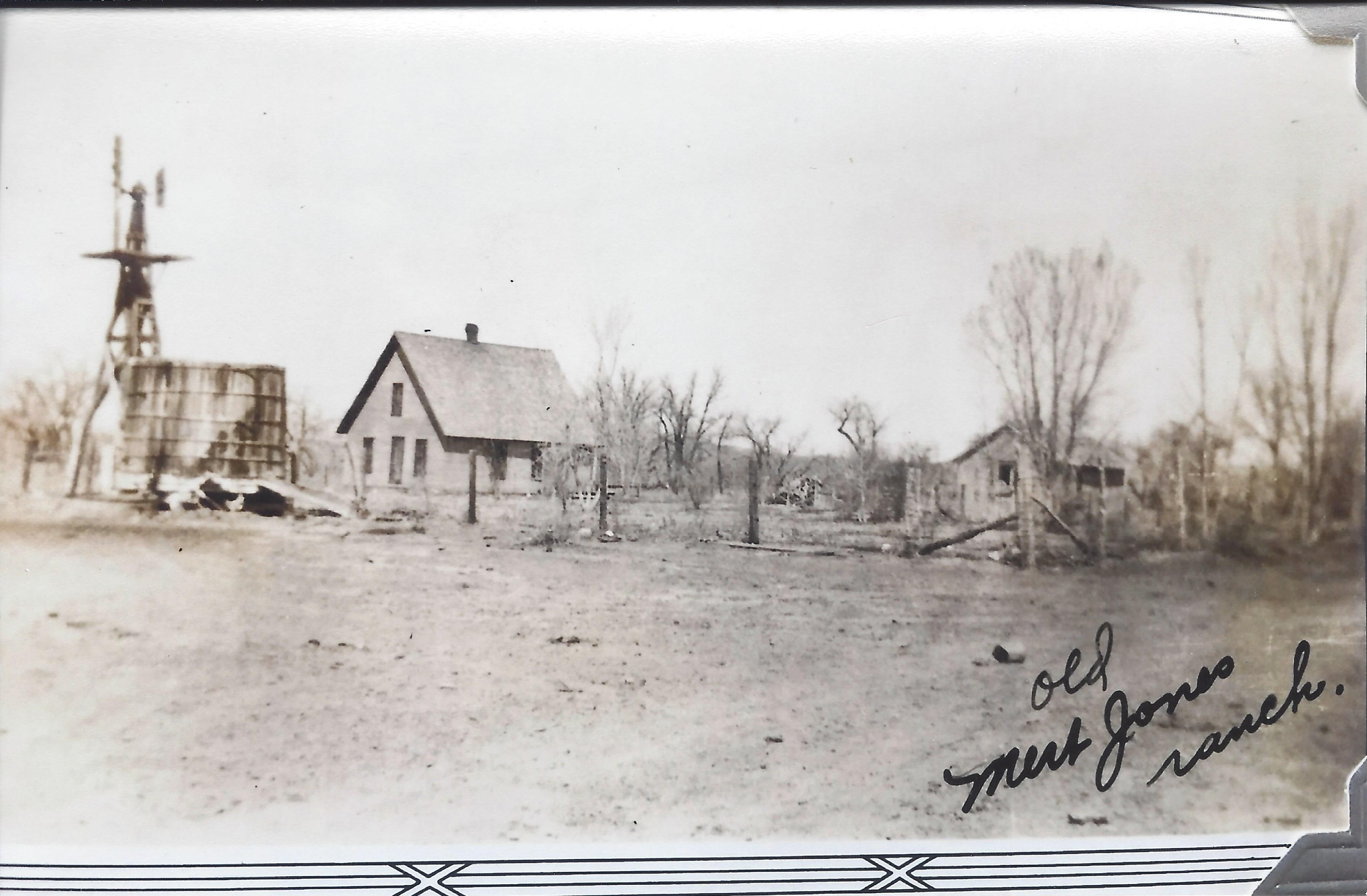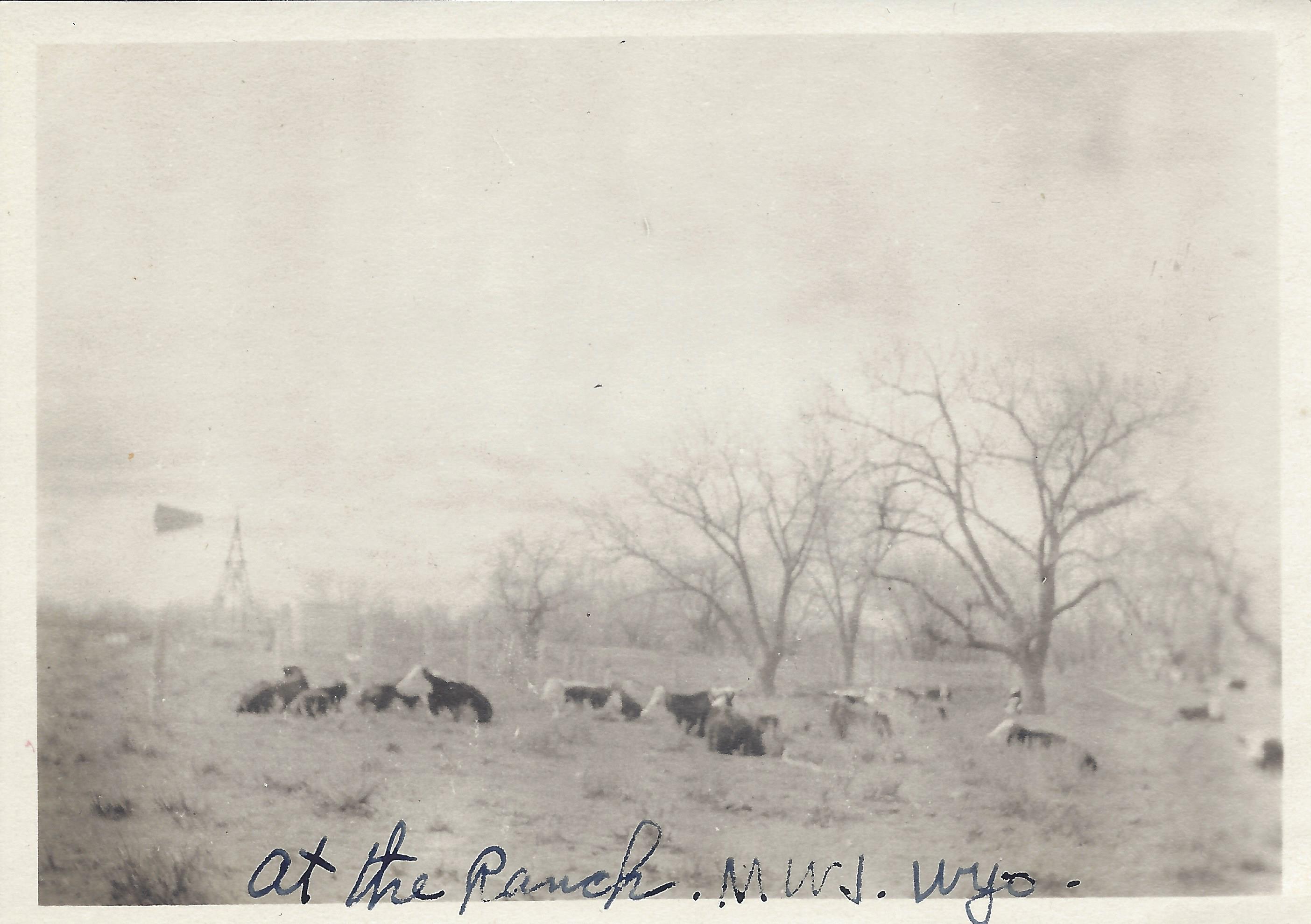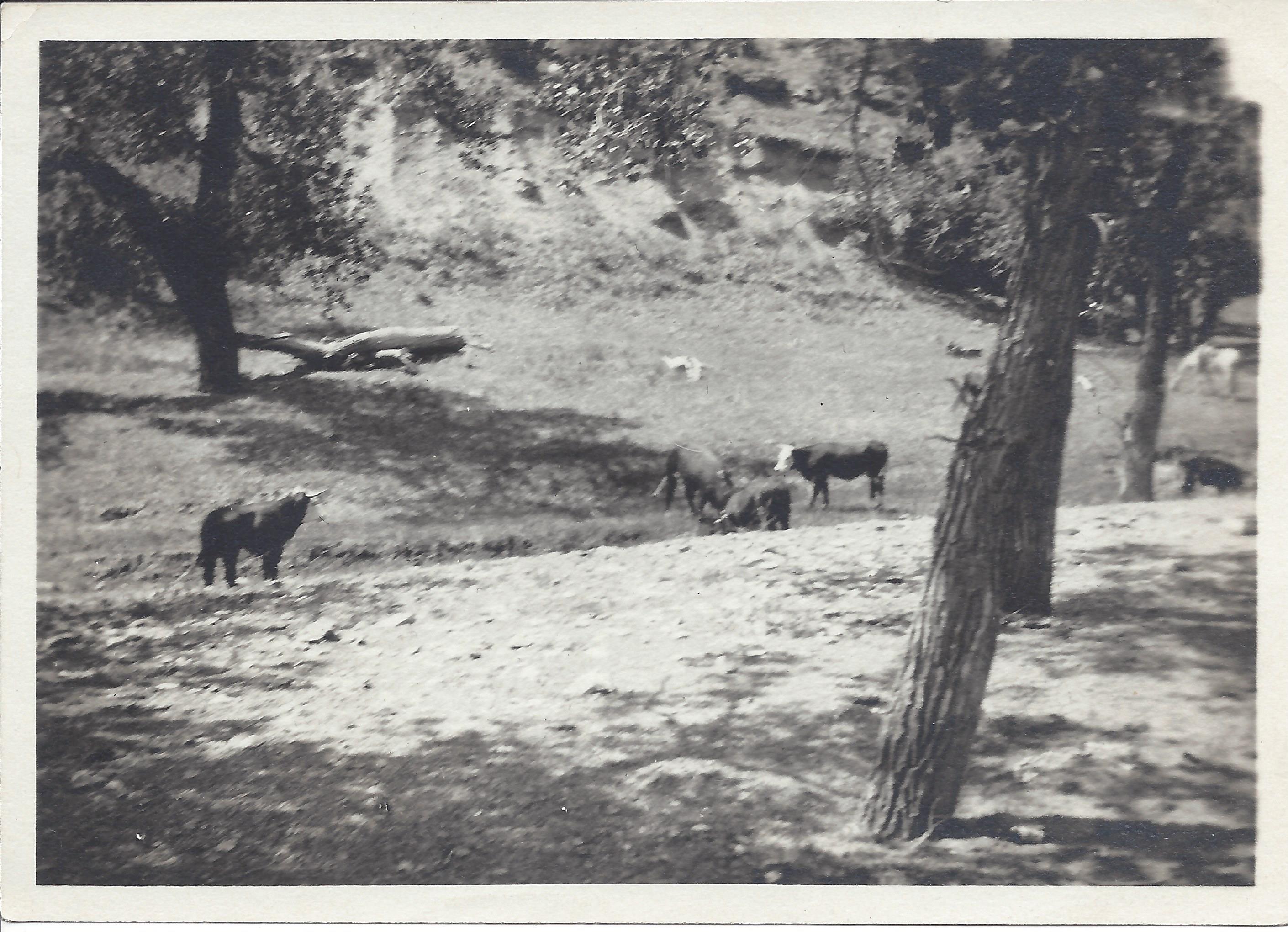Jones, Merton W. Family History
Known as M. W. Jones, ranched in Weston and Converse counties of Wyoming until Converse County was divided into Niobrara County. He left home at the age of 16 years old from Missouri following the rush to the west, to the cattle country and to cowboy life. He lived the life of a cowboy, pioneering and establishing ranch, cattle and horse holdings. I have no date when he came to Wyoming first, but have a letter Mert wrote to Lucy Foote before they were married about 1889 where he was with a herd of cattle in Wyoming. He went to Montana with a trail herd looking for a location to settle. In his letter, he told Lucy he could not get back by July 4th, as he promised but believed he would settle in Wyoming, not in Montana.
He worked awhile for Merritt L. Taylor and wife Henrietta. They were mother and step-father of Lucy F. Foote who Mert later married. This was in Springview, Nebraska which was the county seat of Keya Pha County along the Niobrara River. The Indian word Keya means Turtle and Pha means Hill which was descriptive of the small round hills in the county. Keya Pha was formed from Brown County by vote in 1884 and in later years was overrun by horse thieves including the notorious Doc Middleton and Kid Wade.
Times were hard; heard Henrietta Taylor say she cooked turtle many times and when company came, they couldn’t tell what kind of meat they ate. History says turtles have seven kinds of flavored meat.

Lucy herded the cattle to protect them from wolves and straying for her father Merritt Taylor. She and other women rode side saddles. One day while herding the cattle her saddle turned which threw her backwards over the horses back and her leg was caught in the stirrup. She hung there until dark. When she didn’t get home with the cattle, her father went hunting for her and found her with a broken shoulder. She was riding Little Kite Mare, which was her horse. She got the mare stopped by talking to her and recovering one rein.
Merritt Taylor did lots of hunting where he used an old Powder Horn and later made his own bullets which were molded at the hearth of the wood stove. He had five tanned deer hides which were as soft as chamois skin. Maude Glover, my sister has an old skinning knife and the powder horn and some of the deer hides have paintings on them. Grandma Taylor came walking in with a deer hanging across the saddle with the head nearly to the ground and the feet on the other side. There was a time when Merritt shot a deer and he ran up to bleed it but the deer wasn’t dead. The deer got up and Merritt held on to the horns. It was a contest as to which would win the battle. Merritt finally backed the buck off of a bluff but one of the deer horns had punctured his arm. The deer’s head was mounted and hung at the ranch for as long as we could remember.
During the famous grasshopper years, settlers and ranchers starved out or moved out. Merritt Taylor and Mert Jones went to the Rosebud agency to get permission to move the cattle to one of the lakes on Rosebud where the hoppers had not destroyed the grass. They moved these cattle to the lake on Rosebud, fixed up a camp for the summer at head of Willow Creek and left some supplies there. Merritt told Mert if any Indians cleaned out his camp or other troubles, he should send word by the pet horse Browney who had an extra heavy mane. He said to tie a note under the horse’s mane, take him down the trail a ways, hit him over the rump with a rope and Browney would take off for home in Nebraska and be there by daylight. This was done on several occasions. Could also be one of the first leases or permits issued by the Reservations to white men to run cattle.
Merritt Taylor helped Mert Jones move from Springview, Nebraska to Wyoming settling in Weston and Converse counties. They came by covered wagons, driving their stock [cattle and horses] with them. Merritt was a horseman which he owned and raised lots of wonderful horses. The horses were branded MT on the shoulder and the cattle were branded MT Bar under. They located on Lightening Creek and lived there all their lives until they sold out in 1908 and retired to live in Lusk, WY. Merritt had the second Post Office established in Converse County which was called Taylorville. The ranch was known as Taylorville from then on. The first Post Office was at Warren, Wyoming Converse County on the Mert Jones ranch on Lance Creek which was about 35 miles from Taylorville. The first Post Office pigeon hole boxes were made by Lucy Jones.

Mert worked for the AU7 ranch at the mouth Lodge Pole Creek on the Cheyenne River. It was on the old Taylor Trail crossing for the big cattle herds. AU7 had lots of horses, 300 or 400 saddle horses. In the winter, Mert and Tom Wagner rode line on these saddle horses from one ranch to another. Tom Wagner lived on Hay Creek, and he was a very good horseman. Mert and line riders stayed a day or two or overnight at Wagner’s place, then back to AU7 for two or three days. Mert worked for /V on Cheyenne River until they sold out, two years for the 4W, two years for FS, then E.W. Whittcome outfit and the Fiddleback until he started a ranch of his own.
Mert and Lucy and baby Mae lived through those years mostly on Cheyenne River, Weston County. Lucy tells of watching the cattle one morning about daylight while Mert was on the roundups. She heard the cattle bawling. She saddled Browney and taking Mae, galloped over the hill to find three grey wolves that had a calf down. It was still alive and bawling. When she got nearer, she saw their heads in the calves flank eating on the calf. The wolves looked up and they were covered with blood to their shoulders.
Lucy and Mrs. Bill Harris were the only two women in that whole country which was too far to visit very often. Mrs. Harris had two boys and Lucy had two girls. Maude was born by then. Mert and Lucy had lost twin boys and a girl between Mae and Maude. Lucy was alone with Mae who was two years old, unattended during the birth of the twins. A cowboy, Ephe Stone was riding thru and stopped. She sent him to Lightening Creek for her mother, Mrs. Taylor and to find Mert at some roundup wagon. Stone made it about daylight, his horse was played out. Ephe said when he turned his plate over at breakfast, he found a $20 bill.
About 1897, Mert went over to Lance Creek and bought the ULA ranch from J.B. Kendrick and Keating who had built a long 3 or 4 room log house with a stone fireplace in one end and a long hitch rail in front. Kendrick later became Governor of Wyoming. Verdi Jones was born in the house in 1899. Mert had an old blue print picture of this long ranch house. Many years later the history hunters, in writing the life of Kendrick asked May Jones for a copy of the picture for their book. Am sure May has a copy or the original picture.
A FEW MEMORIES HERE; Verdi about 2 or 3 years old, ran out to the hitch rail behind a sorrel horse that was tied there. He kicked, but she was close enough to grab his hind leg and hold on. The horse crouched down until Lucy got her loose.
The only time Mert ever whipped any of us was when May got Maude and Verdi on the partition fence at the corral. They were weaning calves and May ran them around and we would kick our feet and laugh. Mert rode up, got us off the fence and all three went to the barn. He picked up a piece of sage brush roots and cracked each of us.
Every summer or fall for years, 4 or 5 Indian wagons would come thru and camp near the house and barn. They traded bead work for chickens, beef and dogs. In the course of time, the Squaws made the three of us each a pair of moccasins which May and I still have. Wish I knew the name of the Indians family. They were friendly and went on their way.
Lance Creek began caving its banks and before long the ULA ranch house would be in a danger spot. Mert and Lucy decided to build a ranch house across Lance Creek on the south side.

This was quite a stately house to us. Where did the men get the know how? It was made of hewed logs, dove tailed on corners and the cracks between logs outside were dobbed with plaster. It was white, not mud dobbed as are most log houses. The lumber for its flooring roofing and shingles was hauled from Crawford, Nebr. There were 5 rooms and pantry down stairs, 4 rooms up-stairs. There was a well under the kitchen with pitcher pump and sink in kitchen. The rooms inside walls were plastered with lime over lathe- they say it was never replaced. The house must be 65 years old.(In 2023 the house is still standing in fairly good shape)

A FEW MEMORIE NOTES FROM LIFE ON THE RANCH
Our play and fun was with horses, rode and broke our colts and yearlings. George Lacy, an old Texas trail hand was with Mert a lot. He lived about a mile and a half from our ranch. We would ride there with 2 or 3 on one horse until we were old enough and had Bell and Victor broke. The others rode Kite double. Lacy treated us as royal guests and sat Verdi and Verona on the table and opened his box of 5 lb. wooden case of raisins or prunes. We could eat all we wanted, can’t remember getting sick. Another time he took his twenty-two to the cabin door, shot a chicken, skinned it and cooked it for us.
Will never forgot Billie Smythe coming to the ranch. He was a big, tall kid that came from Alex Jones place in Missouri and never left Wyoming. Alex was Mert’s brother. He walked out from Lusk; it was raining and about dark. He homesteaded a nice piece of land near the Jones ranch. Always marveled at his memory. He memorized long poems, the Preamble of the U.S. and gave them at Literary which the folks had occasionally.
About 1903, when Sheriff Billy Miller and Johnnie Owens came from Newcastle hunting some Indian wagons off the Reservation, they came to the MWJ ranch and ate supper. This made a marked impression on us kids. I still can see them sitting by the kitchen door with rifles across their knees. They wore long mustaches. The MWJ ranch is about 35 miles from Taylorville. When the posse got there, Merritt Taylor put Henrietta on her horse (side saddle) and sent her across Lightening Creek to hide in some rough bluffs about 2 miles from Taylor’s ranch house. She could hear the gunfire from the fighting as the sheriff overtook the Indians a few miles from Taylorville. She thought all the men would be killed. Sheriff Miller was killed.
Progress overtook people and places even in those days. Mert Jones got a saw mill which was run by horse power and all the neighbors came to help. Believe all they got sawed were 2x4’s and he got lots of razzing about 2 x 4 Jones sawmill.

He got a hog somewhere; he and the neighbors went to Merritt Taylor to show them how to butcher it.
Grandfather Merritt Taylor ordered by mail and received the first Edison Phonograph, cylinder type with a large morning glory horn. It came to the Warren Post office. Quite an occasion when they came and set the Edison up and again the neighbors came. Merritt got it playing and I remember two records “Marching Through Georgia” and “Swannee River”.
Schools came next, teachers from the East came and some cowboys married them before the term was over. Had 3 month and 5 month terms. Two of the first came from Detroit and taught the Jones school. They were Florence Goddard and Josephine Craig. They rode horseback to school. Roy Lemmon furnished Florence an old roan race horse, none of the kids could keep up with him.
Lucy and Florence Goddard made themselves and wore the first divided skirts-rode astride- was nearly too daring to attempt.
About 1911 we went away to school at O’Neill, Nebr. And each finished high school and received teacher certificates.
Mert was the first rancher to try irrigation in those parts, perhaps Wyoming. He put a big engine pump on Lance Creek, west of the house and got water out on the flat for hay. In 2 or 3 years, high water cut out the bank and he lost the engine. Later years, people on the ranch have irrigated the flat.

About 1914, Aunt Zade Baker wrote the girls at school. Mert had a young man working instead of always having old men work. That June, Aunt Zade had a dance at Billie Smythe’s place for the girl’s homecoming. All came to the ranch for breakfast the next morning, Ada and Winnie Galbreath, Myrtle, Effie and Nellie Bonner, Helen Hogan, May, Maude, Verdi and Verona Jones. The new man was John Glover. Mert met him at the door and said “You better have a bracer before you meet all those girls” Always said he couldn’t eat breakfast.
John and Maude Glover were married 1916
May and Hans Meng were married 1917
Verdi and Bob Jensen were married 1917
Verona and George Cover were married 1920
Dorothy and John Walker were married in California
Mert sold out the ranch in 1916 to Townley & Curey and retired to Brighton. Colo. And later to California where he died in 1942.
Merritt and Henrietta sold their ranch in 1908 and moved to Lusk where Merritt died in 1910
Lucy died in Denver in 1927
This story was reprinted by Jim Meng [Great grandson of Mert Jones]
* * * * * * * * * * * *
MERTON W. JONES
Mert Jones was born December 10, 1866, in Missouri. He came to Nebraska in his early youth and worked for various outfits around Valentine and Ogallala, when these two lively little frontier towns received the tribute of millions of cattle from the great trail herds.
Valentine was also an Indian trading center, and Indians were there to receive their rations. Mert was master of several Indian languages, including the sign language. He married Lucy Foot, daughter of Mr. and Mrs. Merritt Taylor in Springview, Neb. The couple moved west soon afterward, and took up ranching at the OS ranch on the Cheyenne River. He later homesteaded a tract of land on Lance Creek, and turned to ranching in earnest. While living in this part of the country, Mert worked for the 4W and Fiddleback wagons. He enjoyed telling jokes on himself and related many funny happenings of the early days. He said his first job was on a little chicken ranch in Kansas, and there he accumulated enough money to buy a pair of high-heeled boots, and then he sent in his resignation as a chicken wrangler, and found himself in Western Kansas Broke. His first opportunity for work was breaking prairie, and high-heel boots and his heels only lasted about six days. He bought a pair of shoes from the farmer for $2 and left, destination unknown, but landed in Valentine, Neb., with a few stop-overs to let his sore feet rest.
After securing a job at the 4W, someone asked Mert where he had come from, and he replied, “Maine .” He proved to be such a good hand the old cowpokes began to wonder “how come”—and asked what part of Maine he was from. Mert replied, “the main part of Missouri, where they raise, pigs, pumpkins and plow boys.”
In1897, Mert purchased the ULA ranch from William Keating, and he and his family moved down there that fall.
Mert Jones was considered one of the best cowmen in this part of the State. Most every year he was appointed foreman of the Indian Creek pool wagon. The Indian Creek pool wagon was from the east and there was also another wagon, the 4J, from the west. The roundup expenses were paid by different stockmen, the money being raised by assessing all stock owners a certain amount in the districts connected with the roundup. Mert Jones represented the very highest type of a Wyoming pioneer. His experiences were many and varied. He was always ready and willing to help his friends and neighbors.
Mr. and Mrs. Jones were the parents of five daughters---Mrs. May Meng, deceased; Mrs. Maude Glover, Porcupine, So. Dak.; Mrs. Verdi Jensen, deceased; Mrs. Verona Covert, Scenic, So. Dak.; and Dorothy Walker, San Francisco, Calif.
Mr. Jones died in 1942 ant Wilmer, Calif.
(Excerpt from "Pioneering on the Cheyenne River" and used by permission)
Images & Attachments
Related/Linked Records
| Record Type | Name | |
|---|---|---|
| Obituary | Meng, Hazel (03/26/1893 - 11/17/1942) | View Record | Obituary | Meng, Hans (04/04/1886 - 01/26/1961) | View Record | Obituary | Jones, Merton (12/10/1866 - 06/12/1942) | View Record |
